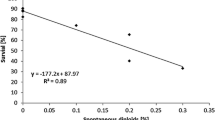Abstract
Androgenesis is a potentially valuable technique for recovering fish from gene banks composed of cryopreserved sperm, developing inbred lines, and analyzing patterns of inheritance. The procedure for producing diploid organisms whose nuclear DNA is wholly of paternal origin is dependent on: (1) the denucleation of “host” eggs, and (2) the inhibition of the first mitotic division in order to double the haploid sperm chromosome complement following fertilization of host eggs. Denucleation of tilapia (Oreochromis niloticus L.) eggs was carried out using UV irradiation. Treatment durations of 5–8 min (total dose of 450–720 J/m2) produced acceptable yields of viable denucleated eggs [22.9±1.6% (±SE) of controls] as estimated by the survival of haploid androgenetic tilapia to 48 h post-fertilization. Successful mitotic inhibition was accomplished using a heat-shock of 42.5 °C for 3–4 min, applied at 2.5-min intervals from 22.5 to 30 min post-fertilization (mpf). The mean survival of androgenetic diploid fish to yolk-sac absorption for treatment groups varied from 0.4% to 5.3%, relative to the controls. Differences in the suceptibility of eggs from different females to UV irradiation were a significant factor in the overall yield of androgenetic diploids. Paternal effects did not significantly influence the androgenetic yield, suggesting that individual males would not be selected against. For comparative purposes mitotic gynogenetic “mitogyne” diploids were produced from UV-irradiated sperm. Mean survival to yolk-sac absorption varied from 0.5% to 10.64%, relative to controls. Similar optima for androgenetic and gynogenetic induction were found in the period 25–27.5 mpf (minutes post-fertilization). Induction treatments would appear to be operating on the same developmental events in both these techniques, and the results suggest that the UV irradiations used do relatively little damage to the eggs beyond nuclear inactivation. The results indicate that the production of androgenetic O. niloticus is possible on a consistent basis and that the application of this technique may be useful in quantitative and conservation genetics.
Similar content being viewed by others
References
Arai K, Onozato H, Yamasaki F (1979) Artificial androgenesis induced with gamma irradiation in masu salmon, Oncorhyuchus masou. Bull Fac Fish Hokkaido Univ 30:181–186
Bongers ABJ, Veld EPC, Abo Hashema K, Bremmer IM, Eding EH, Komen J, Richter CJJ (1994) Androgenesis in common carp, (Cyprinus carpio L.), using UV-irradiation in a synthetic ovarian fluid and heat shocks. Aquaculture 122:119–132
Chapman RW, Powers DA (1984) A method for the rapid isolation of mitochondrial DNA from fishes. Maryland Sea Grant Program Technical Report UM-SG-TS-84-05
Chourrout D (1984) Pressure-induced retention of second polar body and suppression of first cleavage in rainbow trout: production of all-triploids, all-tetraploids, and heterozygous and homozygous diploid gynogenetics. Aquaculture 36:111–126
Don J, Avtalion RR (1988) Production of F1 and F2 diploid gynogenetic tilapias and analysis of the “Hertwig curve” obtained using ultraviolet irradiated sperm. Theor Appl Genet 76:687–692
Garcia MAR (1991) Cytological and induced spawning techniques for research on gynogenesis and polyploidy in Nile tilapia. MSc thesis, University College of Swansea, Wales
Gillespie LL, Armstrong JB (1980) Production of androgenetic diploid axolotls by suppression of first cleavage. J Exp Zool 201:423–425
Gurdon JB (1960) The effects of UV irradiation on the uncleaved eggs of Xenopus laevis. Microsc Sci 101:299–311
Hartwell LH, Weinhert TA (1989) Checkpoints: controls that ensure the order of cell cycle events. Science 262:629–634
Hussain MG, Penman DJ, McAndrew BJ, Johnstone R (1993) Suppression of first cleavage in the Nile tilapia, Oreochromis niloticus L. — a comparison of the relative effectiveness of pressure and heat shocks. Aquaculture 111:263–270
Johnstone R (1993) Optimisation of ploidy manipulation procedures. In: Penman D, Roongratri N, McAndrew B (eds) Proc 1st AADCP Int Workshop Genet Aquac Fish Management. ASEAN-EC Aquaculture Development and Coordination Programme (AADCP/Proc/3), Bangkok, Thailand, pp 37–40
Kligerman AD, Bloom SE (1977) Rapid chromosome preparations from solid tissues of fishes. J Fish Res Board Can 34:266–269
Kowtal GV (1987) Preliminary experiments in induction of polyploidy, gynogenesis, and androgenesis in the white sturgeon, Acipenser transmontanus Richardson. In: Tiews K (ed) Proc World Symp Selection, Hybridization Genet Engineering Aquaculture, vol 2. Heenemann, Berlin, pp 317–324
Mair GC (1993) Chromosome manipulation in tilapia — techniques, problems and prospects. Aquaculture 111:227–244
Majumdar KC, McAndrew BJ (1986) Relative DNA content of somatic nuclei and chromosomal studies in three genera, Tilapia, Sarotherodon, and Oreochromis of the tribe Tilapiini (Pisces, Cichlidae). Genetica 68:175–188
May B, Henley KH, Krueger CC, Gloss SP (1988) Androgenesis as a mechanism for chromosome set manipulation in brook trout (Salvelinus fontinalis). Aquaculture 75:57–70
McAndrew BJ, Majumdar KC (1983) Tilapia stock identification using electrophoretic markers. Aquaculture 30:249–261
McAndrew BJ, Roubal FR, Roberts RJ, Bullock AM, McEwen IM (1988) The genetics and histology of red, blond and associated colour variants in Oreochromis niloticus. Genetica 76:127–137
McAndrew BJ, Rana KJ, Penman DJ (1993) Conservation and preservation of genetic variation in aquatic organisms. In: Muir JF, Roberts RJ (eds) Recent advances in aquaculture, vol 4. Blackwell Scientific Publ, London, pp 296–336
Myers JM, Penman DJ, McAndrew BJ, Rana KJ (1993) Genetic manipulations and gene banking in tilapia. In: In: Penman D, Roongratri N, McAndrew B (eds) Proc 1 st AADCP Int Workshop Genet Aquae Fish Management. ASEAN-EC Aquaculture Development and Coordination Programme (AADCP/Proc/3), Bangkok, Thailand, pp 97–100
Parsons JE, Thorgaard GH (1985) Production of androgenetic diploid rainbow trout. J Her 76:57–70
Purdom CE (1969) Radiation induced gynogenesis and androgenesis in fish. Heredity 24:431–444
Scheerer PD, Thorgaard GH, Allendorf FW, Knudsen KL (1986) Androgenetic rainbow trout produced from inbred and outbred sperm sources show similar survival. Aquaculture 57:289–298
Scott AG, Mair GC, Skibinski DOF, Beardmore JA (1987) “Blond”: a useful new genetic marker in the tilapia Oreochromis niloticus L. Aquae Fish Management 18:159–165
Yamazaki F (1983) Sex control and manipulation in fish. Aquaculture 33:329–354
Author information
Authors and Affiliations
Additional information
Communicated by C. Smith
Rights and permissions
About this article
Cite this article
Myers, J.M., Penman, D.J., Basavaraju, Y. et al. Induction of diploid androgenetic and mitotic gynogenetic Nile tilapia (Oreochromis niloticus L.). Theoret. Appl. Genetics 90, 205–210 (1995). https://doi.org/10.1007/BF00222203
Received:
Accepted:
Issue Date:
DOI: https://doi.org/10.1007/BF00222203




